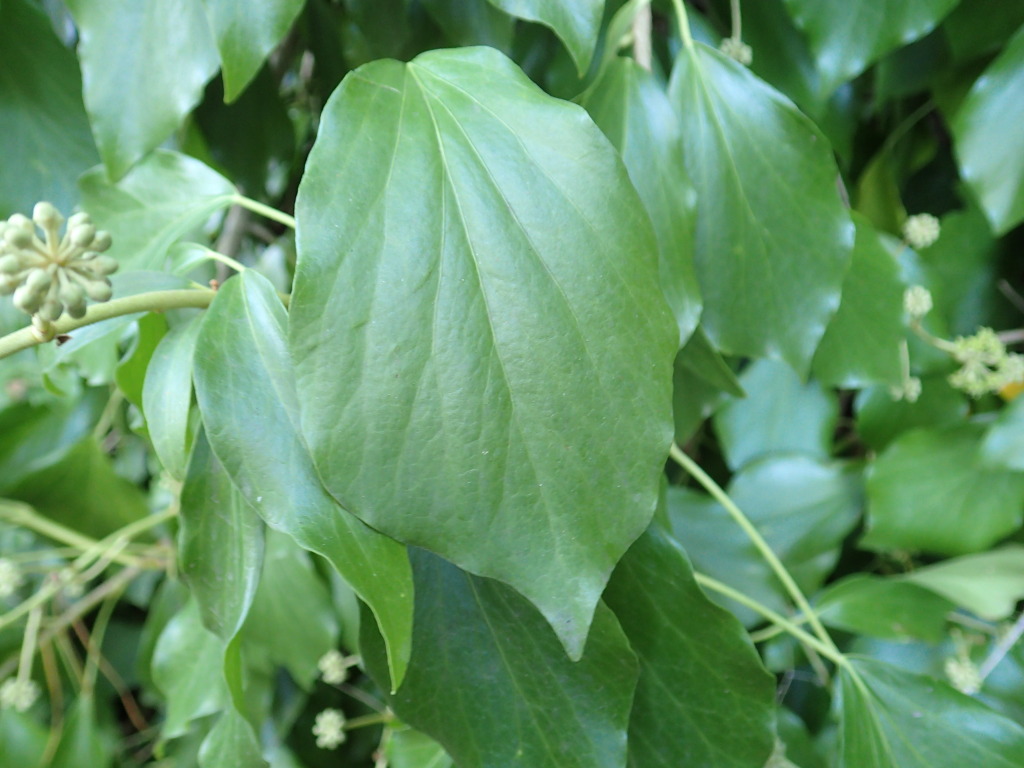Hedera hibernica
(G.Kirchn.) Bean Atlantic IvyHeteroblastic woody climber (to 20 m or more) or creeper, older plants becoming shrub-like, usually with aerial roots along the stems. Hairs on young leaves and young stems in vegetative shoots stellate, generally sessile, the central part occupying 1/6–1/3 of the diameter, hairs often pale yellowish brown, sometimes white or off-white, or orange or tan in the centre with rays mostly white or off-white, or indumentum a mixture of these colours, rays 4–12(–15) radiating in a plane parallel to the leaf blade, rays often of similar length. Leaves in non-flowering shoots 4–10 cm long, 4–10 cm wide, sometimes > 8 cm wide, frequently as wide as long, 3–5 lobed, usually lobed less than ½ way to base with lobes often as wide as long, lobes triangular or oblong, outline usually palmate and ‘ivy-shaped’, base rounded to truncate; upper leaf surface pale green to dark green, surface very variable, more or less dull or somewhat glossy; petiole 2–10(–13) cm long. Leaves on flowering shoots entire and more or less triangular-ovate, 3–10 cm long and wide, leaf base truncate; petioles 2.5–11 cm long. Inflorescence a panicle of umbels, with an umbel terminating each inflorescence branch; petals greenish; styles stout, united, c. 1.5 mm long, persistent. Fruit dull dark blue to black, 5–10 mm diam.
GleP, VVP, VRiv, GipP, OtP, WaP, CVU, NIS, HSF, HNF, OtR, Strz. Also naturalised SA, NSW, ACT, Tas. Native to western Spain and Portugal, western France and Britain. A serious environmental weed of riparian sites, damp and wet sclerophyll forest, dry sclerophyll forest and woodland, rocky outcrop vegetation (Carr et al. 1992), and coastal cliffs.
Hedera hibernica is the more prevalent of the two species of Hedera naturalised in Victoria, but the name H. helix has been widely misapplied to this species. Hedera hibernica differs from H. helix most significantly significantly in trichome characters (diagnostic, see key), and in the leaves often lobed > 1/2 way to the base with lobes usually longer than wide, although the leaf character should not be relied on alone for identification and may not always be reliable, and 2n = 48 (Stace 2010).. In a study of the naturalised Hedera populations in the Pacific Northwest region of USA, it was found that 83 % of the sampled populations were H. hibernica and not H. helix as previously thought (Clarke et al. 2006).
Records from the Victorian Biodiversity Atlas, and records from Australia's Virtual Herbarium that are not based on MEL specimens are not displayed on the map because it is unclear what species they pertain to.
Cultivated for its decorative foliage and dense climbing habit.
Clarke, M.M., Reichard, S. & Hamilton, C.W. (2006). Prevalence of different horticultural taxa of Ivy (Hedera spp., Araliaceae) in invading populations. Biological Invasions 8(2):149-157.
McAllister, H. & Marshall, R. (2017). Hedera: The complete guide. RHS Horticultural Monograph.
Stace, C. (2010). New Flora of the British Isles (3rd edn). Cambridge University Press.
 Spinning
SpinningCarr, G.W., Yugovic, J.V.; Robinson, K.E, (1992). Environmental weed invasions in Victoria: Conservation & Management Implications. Dept. of Conservation & Environment, & Ecol. Horticulture .
Clarke, M.M.; Reichard, S.H.; Hamilton, C.W. (2006). Prevalence of different horticultural taxa of Ivy (Hedera spp., Araliaceae) in invading populations. Biological Invasions 8: 149–157.
McAllister, H.; Marshall, R. (2017). Hedera: The complete guide. Royal Horticultural Society.
Stace, C. (2010). New Flora of the British Isles, edn third. Cambridge University Press.


